In 2025, the world-famous Menninger Clinic will celebrate its 100th anniversaryth anniversary. The clinic (often referred to simply as “Menningers”) began in a nondescript farmhouse on the outskirts of Topeka, but soon grew to become the nation’s premier psychiatric facility. Those who worked at Menningers pioneered a new, integrated approach to mental health treatment. Their efforts made Topeka a center for psychiatric treatment, research, and education for more than 70 years.
Beginning with horses and buggies
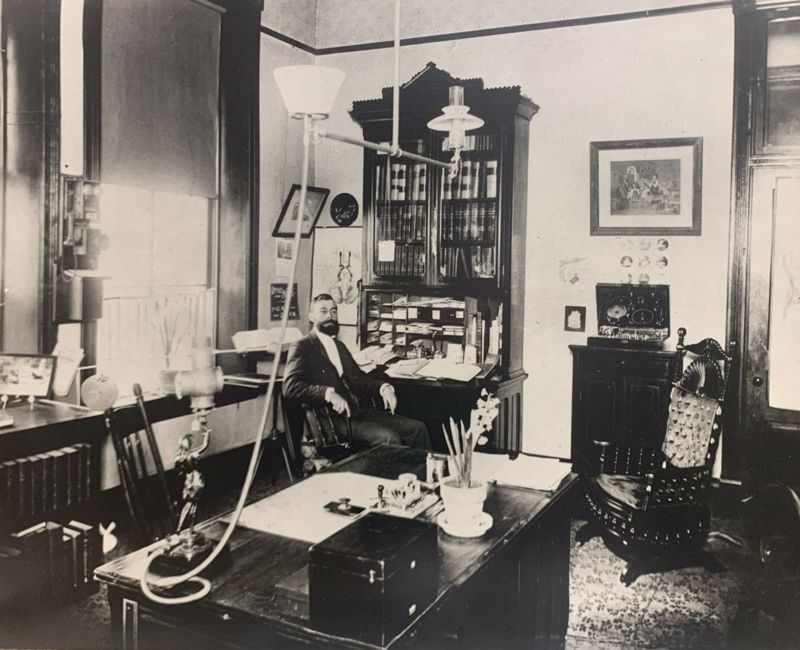 Dr. CF Menninger in his offices at 727 S. Kansas Ave. (TSCPL)
Dr. CF Menninger in his offices at 727 S. Kansas Ave. (TSCPL)
The Menninger family’s story in Topeka began in 1889, when newly minted Dr. Charles Frederick (CF) Menninger and his wife, Flo, moved to the capital city so he could establish a medical practice. He rented office space in the Davis Building at 727 S. Kansas Avenue and soon became the doctor of choice for many Topekan residents, especially German immigrants.
CF and Flo had three sons: Carl, Edwin and William. Both parents expected their boys to be studious and well-rounded. Edwin later recalled that he and his brothers were “required to practice an hour on our various musical instruments between 6 and 7 in the morning.” The boys also accompanied CF on home visits, which he made up to 35 times a day. While the doctor examined his patients, the boys were expected to stay with the buggy, a process they called “holding the horse.” It is no wonder that all three developed an interest in medicine.
Family practice
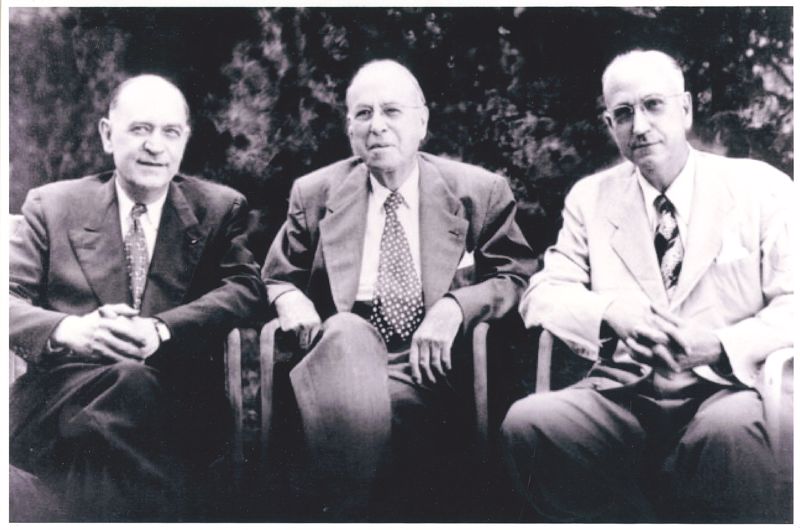 Left to right: Dr. William Menninger, Edwin Menninger, and Dr. Carl Menninger (TSCPL)
Left to right: Dr. William Menninger, Edwin Menninger, and Dr. Carl Menninger (TSCPL)
CF’s aim has always been to work with other practitioners to “share ideas, help and support each other when difficult decisions need to be made in patient care”. In 1919, his oldest son Carl returned to Topeka after receiving his medical degree from Harvard Medical School. Carl developed an interest in psychology during his residency at the Boston Psychiatric Hospital. He and his father founded the Menninger Diagnostic Clinic. A few years later, after receiving his doctorate, William (Will) joined his father and brother in the clinic.
In 1925, the Menningers expanded their practice with the purchase of a farmhouse at 3535 SW 6th Ave, which at the time was outside the city limits. This became the first Menninger Clinic and Sanatorium and the first group psychiatric practice in the United States. By February 1926, the building was occupied by 14 patients, which was its maximum capacity. Over the next few years, the clinic and sanatorium expanded to become a large campus that occupied most of the space of 6th Ave between Gage and Watson.
Many were attracted to the Menningers because of their practice of “dynamic psychiatry.” Patients there were not seen as “cases” but as individuals in need of treatment. Instead of isolating patients from their families and society at large, doctors at Menningers involve the family in as many steps of treatment as possible. The main goal was for the patient to be able to return to society, as Dr. Carl said, “better than good.”
Beyond treatment
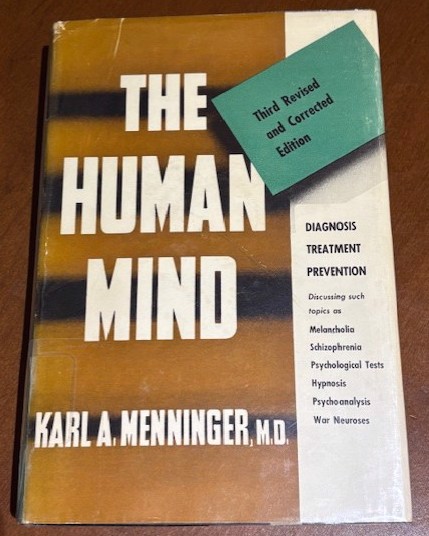 Dr. Carl Menninger’s First Book, The Human Mind, Becomes a Bestseller (TSCPL)
Dr. Carl Menninger’s First Book, The Human Mind, Becomes a Bestseller (TSCPL)
When Menningers started, psychiatry was still a relatively unknown discipline. Carl hoped to change society’s perception of the mentally ill by writing articles and books aimed at ordinary people. In 1930 he published his first book, The human mindwhich became a bestseller. He has also published articles in Ladies home magazine and had a regular advice column in the magazine.
In 1941, the family established the Menninger Foundation as a non-profit arm of its operations. As the clinic and other branches of the Menningers began to rely more and more on grants, the Foundation was created to help the money go where it needs to go faster.
Will has also been integral in raising awareness of mental health treatments. During World War II, he was appointed chief psychiatric consultant to the US Surgeon General. By the end of the war, he was promoted to brigadier general, the highest rank to which a psychiatrist had been assigned up to that time.
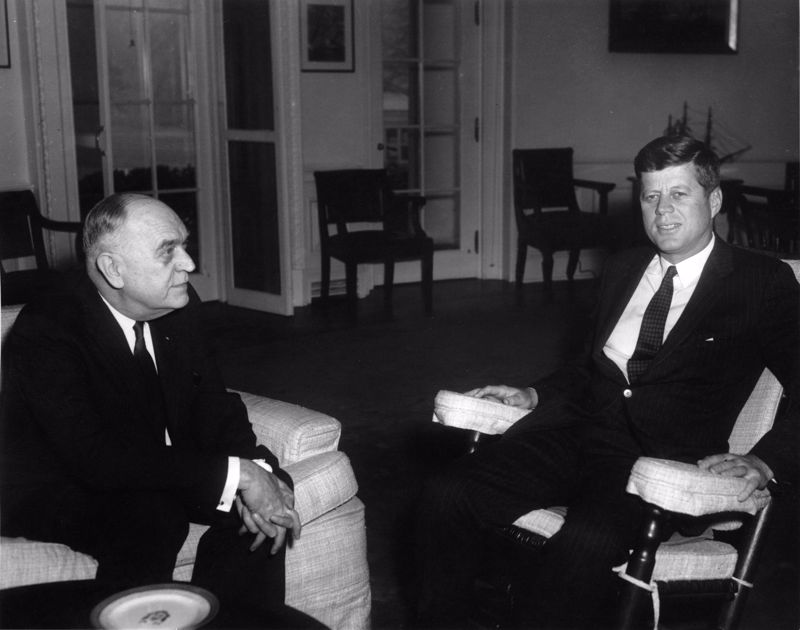 Dr. William Menninger meeting with President John F. Kennedy (Abby Rowe. White House Photographs. John F. Kennedy Presidential Library and Museum, Boston)
Dr. William Menninger meeting with President John F. Kennedy (Abby Rowe. White House Photographs. John F. Kennedy Presidential Library and Museum, Boston)
Will’s contacts in the armed forces spoke to him about the need for more psychiatrists to deal with those returning from war with “battle fatigue”, now known as PTSD. Thus began the Menninger School of Psychiatry, later renamed the Carl Menninger School of Psychiatry and Mental Health. It quickly became the largest training center in the world.
On the hill
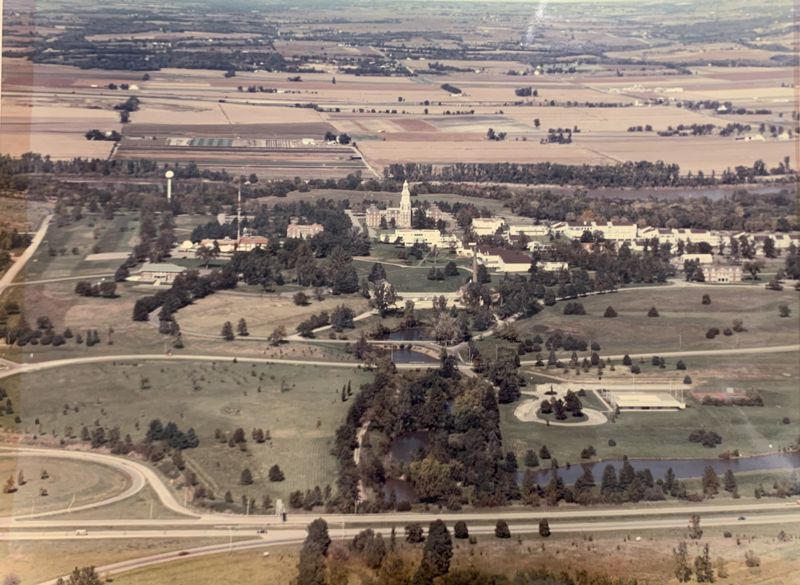 Aerial view of the Menninger Foundation West Campus (TSCPL)
Aerial view of the Menninger Foundation West Campus (TSCPL)
In 1954, the Menningers expanded their operations when they began leasing 40 acres on Martin Hill, west of Topeka. The hill was formerly home to the Security Benefit Association Hospital. At first, the West Campus (as it came to be known) housed staff offices and was home to programs such as Industrial Mental Health, Marriage and Religion Counseling Services, and Psychiatry. Eventually, the Menningers purchased the entire 373-acre site and moved all of their operations to the hill.
Between the mid-1950s and mid-1960s, the third generation of Menninger doctors joined the family business. Dr. Carl’s son, Robert, received his medical degree from the University of Rochester School of Medicine and returned to Topeka for residency at the Menninger School of Psychiatry. He later became director of the museum and archives program at Menningers.
Two of Dr. Will’s sons, Roy and Walter, became psychiatrists and rose through the Menninger hierarchy. Dr. Roy Menninger eventually became president and CEO of the Foundation after his father’s death in 1967. He served in that position until his retirement in 1993. Dr. Walter Menninger served as dean of the Menninger School of Psychiatry and took over as president and CEO of the foundation after his brother’s retirement, serving in that position until 2001.
By the 1980s, Topeka was known as the psychiatric center of the world, and Menningers had a worldwide reputation as a place for mental health treatment and training. Menningers had a contract with the NFL to take care of his players. Members of the rich and famous from New York and California traveled to Topeka seeking the help of the Menninger doctors.
The parting of the ways
 Topeka Capital-Journal headline, September 28, 2000 (TSCPL)
Topeka Capital-Journal headline, September 28, 2000 (TSCPL)
Unfortunately, the 1990s saw a change in the way insurance companies handled mental health treatment. They no longer pay for long-term care like that done at Menningers. Rising operating costs meant the Menninger Foundation was losing money.
In September 2000, the Menninger Foundation announced that it would leave Topeka and move to Houston, Texas to partner with Baylor College of Medicine. To preserve the “Menninger spirit” cultivated in Kansas, many of the employees also moved to Houston. In May 2003, the last patient left the Topeka campus and the Menninger Foundation closed its doors.
Today, many of the old buildings on the Menninger campus are still empty or demolished. In 2013, the Sunflower Foundation purchased 13 acres on the hill that encompassed the old nursing home and power plant, and turned the two buildings into their new offices and nonprofit center. The clock tower, long a well-known feature of the Topeka skyline, was recently purchased by a developer. His fate is unknown.
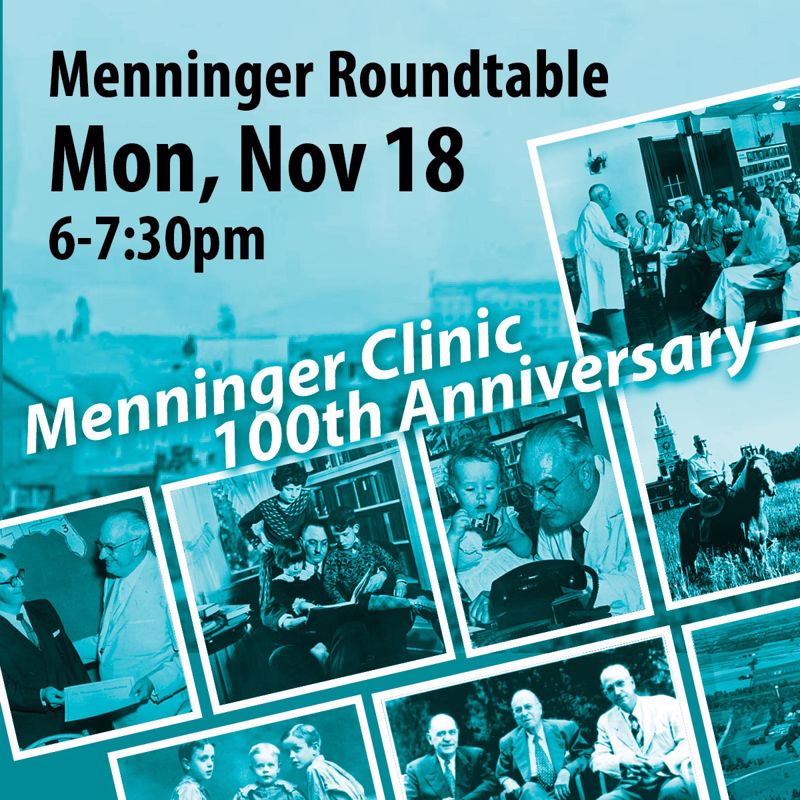 To learn more about the history of the Menninger Clinic and hear stories from those who worked there, including Dr. Walt Menninger, please join us on Monday, November 18, 2024, 6:00 pm at the Marvin Auditorium as the library hosts a Menninger Roundtable with the Shawnee County Historical Society.
To learn more about the history of the Menninger Clinic and hear stories from those who worked there, including Dr. Walt Menninger, please join us on Monday, November 18, 2024, 6:00 pm at the Marvin Auditorium as the library hosts a Menninger Roundtable with the Shawnee County Historical Society.

